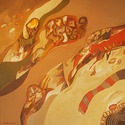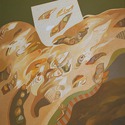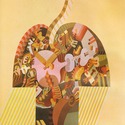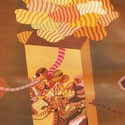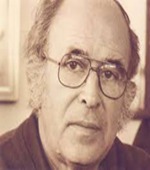
Mehmed Zaimović
Mehmed Zaimović (Tuzla, August 26, 1938 - Sarajevo, September 30, 2011) is an artist from Bosnia and Herzegovina. He graduated from the School of Applied Arts in Sarajevo in 1961. He was engaged in the art of painting, drawing, graphics and book layouts.
He spent his first years at a family property in Tuzla, where he had established deep contact with nature since early childhood.
A profound role at the beginning of his work was played by an art professor, Dragiša Trifković and then by the fine sculptor Franjo Leder. Thereafter, he moved to Sarajevo and enrolled at the School of Applied Arts in Sarajevo (at the Department of Painting) along with following professors: Petar Šain, Vojo Dimitrijević, Mica Todorević and Rizah Štetić.
1961 - He graduated and exhibited for the first time as a visiting artist at the Collective Exhibition of ULUBiH (Association of Artists in Bosnia and Herzegovina) in Split.
1964 - First solo exhibition in the drawing-room "Lik" in Sarajevo. He is editing his small atelier in Glođina Street. He becomes a member of ULUBiH and gains the status of a free artist.
The artist''s first exhibition in Sarajevo was a symbol of ornamentation, in order to percieve the sense for arabesque and symbolism of the Orient. In his work, Zaimović summed up the experience of several basic tendencies of contemporary painting, creating a peculiar world of shapes, which is modern, and simultaneously firmly rooted and firmly bound to Bosnia and its spiritual places.
1967 - He went to Paris as a scholar of the "Moša Pijad" Fund and in the following year received a scholarship from the Cultural Government Fund of Bosnia and Herzegovina for studying in France.
1968 - One of the founders of the Sarajevo Saloon.
1971 - He was elected as a member of the organizing committee of the exhibition "Art in Yugoslavia from Prehistory til Today" in Paris.
1974 - He moved into his atelier in Kulovic Street 3 in Sarajevo. It was followed by a sequence of many collective and independent exhibitions, as well as many awards and acknowledgements.
1976 - Became a member of the "Group 69" from Ljubljana.
1979 - He was elected for a member of the Accademia Italia del Arte del Lavoro in Parmi.
1986 - He became the president of ULUBiH.
The Period of Aggression on Bosnia and Herzegovina 1992-1996 he spent with his family in Sarajevo. Six months after the beginning of the aggression he began to work again, and created a drawing cycle called "Pain", which was exhibited in 1993 at the gallery "Gabriel" in Sarajevo. And the second war exhibition he opened with the "Picture" in 1994 in the gallery "Gabriel". He actively participated in the cultural life of Sarajevo during the War.
1995 - During the war battles, the death of his son Karim, a very prominent young journalist and writer. https://bs.wikipedia.org/wiki/Karim_Zaimovi%C4%87
1996 - Reelected as the President of ULUBiH.
2002 - Elected as a correspondent member of the Academy of Science and Art in Bosnia and Herzegovina.
He artisticely designed and edited a huge number of books, monographs and catalogs. A large number of tapestries were derived in accordance with his works.
He had over sixty independent exhibitions. He participated in over five hundred collective and group exhibitions, at many international art events (biennials and triennials of the world art) at representative Art exhibitions of ex Yugoslavia and Bosnia and Herzegovina in many countries of the world. He received over 30 significant awards and prizes for his work in the country and abroad, among others he is the winner of the "Seventeenth Prize of Sarajevo".
In 2002, the monograph "ZAIMOVIĆ" was printed, which deals with the period of 40 years of the author''s city. Works can be found in many museums, galleries, public buildings and private collections in country and abroad.
He lived and worked as a professional artist in Sarajevo.
The Period of Aggression on Bosnia and Herzegovina 1992-1996 he spent with his family in Sarajevo. Six months after the beginning of the aggression he began to work again, and created a drawing cycle called "Pain", which was exhibited in 1993 at the gallery "Gabriel" in Sarajevo. And the second war exhibition he opened with the "Picture" in 1994 in the gallery "Gabriel". He actively participated in the cultural life of Sarajevo during the War.
1995 - During the war battles, the death of his son Karim, a very prominent young journalist and writer. https://bs.wikipedia.org/wiki/Karim_Zaimovi%C4%87
1996 - Reelected as the President of ULUBIH.
2002 - Elected as a correspondent member of the Academy of Science and Art in Bosnia and Herzegovina.
He artisticely designed and edited a huge number of books, monographs and catalogs. A large number of tapestries were derived in accordance with his works.
He had over sixty independent exhibitions. He participated in over five hundred collective and group exhibitions, at many international art events (biennials and triennials of the world art) at representative Art exhibitions of ex Yugoslavia and Bosnia and Herzegovina in many countries of the world. He received over 30 significant awards and prizes for his work in the country and abroad, among others he is the winner of the "Seventeenth Prize of Sarajevo".
In 2002, the monograph "ZAIMOVIĆ" was printed, which deals with the period of 40 years of the author''s city. Works can be found in many museums, galleries, public buildings and private collections in country and abroad.
He lived and worked as a professional artist in Sarajevo.
The world is a big weaving, and in it, everything is random.There are no legalities, there are no rules. The accident is what determines the place of each and every one of us. In such weaving, we are the threads and the knots, the lines that in an incomprehensible logic, that may possess some order, but it is of several types, lines which encounter and diverge, interfere and unravel themselves.Sometimes in such constant outweaving balance can appear. Because no thread can be strained and injected while another one does not unravels and releases.
From the
book od Karim Zaimovića (1971.-1995.)
CHERRY JAM SECRET
"I attended the School for Applied Art. My professors were Mica Todorović, Vojo Dimitrijević, Rizah Štetić and others. Then, it seems to me, things were done differently: we spent a lot of time in school, read, watched the reproduction of the books, regularly visited the old Art Pavilion where many exhibitions were organized. I remember some of our exhibitions coming from Zagreb, Ljubljana, Belgrade .....
The more recent paintings then, seemed to us as far-reaching future. Sarajevo has just emerged into a cultural and art center and these frequent performances by artists held aside at the Exhibition Pavilion had a huge significance for the cultural climate of the city in general ".
Mehmed Zaimović
_______________________________________________________
The period when Mehmed Zaimović attended the National
School of Fine Arts was indeed a time when Sarajevo was just starting to emerge
into a center of art, and the more recent paintings were, nevertheless
"distant future". In the art scene there were still members of
generation educated at the academies of Vienna, Budapest, Krakow and Munich,
from time when Bosnia and Herzegovina was still part of the Austro - Hungarian
Monarchy. The scene was dominated by the middle generation of painters trained
between the two world wars, who were mostly professors of the mentioned school.
And while the middle generation maintained its artistic credo based on the postulates of pre-war poetic realism, and sometimes adapted it to the aesthetic and ideological provisions of the time, the young, third generation from the time of Zaimović''s education had already tried to make some formal shots in the concept of the itself. The depressed roots of conservatism and traditionalism are slowly beginning to melt down, having a lot of help by the numerous exhibitions coming from other more advanced environments. Instead of literal representation, in the organization of the image, subjective view and feeling enters, expressed through the application of the color in which the object loses its volume, begins to overwhelm the flatness, with certain geometry present, and reduction of elements in the play. There are glimmers of fantasy, irrational, first associative landscapes, almost abstract; being found in the essence of the matter and the structure of the material, and there can also a certain increase in the surface area of the first newsmasters in this center, be found. In any case, default themes no longer exist.
Part of the text: Meliha Husedžinović
"ZAIMOVIĆ MONOGRAPHY", page 7 - Sarajevo, 2002.
______________________________________________________
THE ART OF PAINTING AS POETRY
Art Records (1959 - 1996)
MEHMED ZAIMOVIĆ
Muffled values achieve dominant paroxysm. Zaimović
impresses the idea into the picture, but with visceral and mechanical motives.
And everything is really assemled over and over again according to such
exchange. It seems that this could be a disturbance, an overwhelming
imagination, which was overtaken by this creation.
As Zaimovic better leads his drawing, it feels stronger, more metamorphosed and compels the motion to be completed. Its structural elements bend, decline, turn around and release themselves. With this irresistible need for a contrasted expression, everything takes on a natural organic value. And in that crossing of repetition, in those echo driftings, in those hidden ways of being poisonous, in the shaking of these metamorphoses, the drawing is almost tactual, taking on the power of flaring, the galvanic charge.
With the liberation of this ambiguous sign and the dialogue of their complementary truths, Zaimovic''s drawings, underground images of the psychic city, are provocative inventions ........
JEAN-LOUIS DEPIERRIS
(Part of the text: "ZAIMOVIĆ MONOGRAPHY", page 35, Sarajevo, 2002)
_________________________________________________________
As a painter and as an artist, Zaimović is most interested in rhythm, movement, conflicts of most diverse content characters, united in its complete form.
In those drawings, great widths and liberties, flickers, moves, lives its personal life, an immense world of tiny symbols: circles, arrows, dots, curves, points, etc. This rich world blends into a weird compositional crossing of strange directions . No matter how abstract the elements of these drawings are in graphic art view, they are still very close to the human eye with their conceptual meaning. There is one enormously potential-minded fortune which is identified with some deeply subconscious emotion of man.
EDO NUMANKADIĆ,
Drawings by Mehmed Zaimović, OUR DAYS, Sarajevo 13.V.1969.









